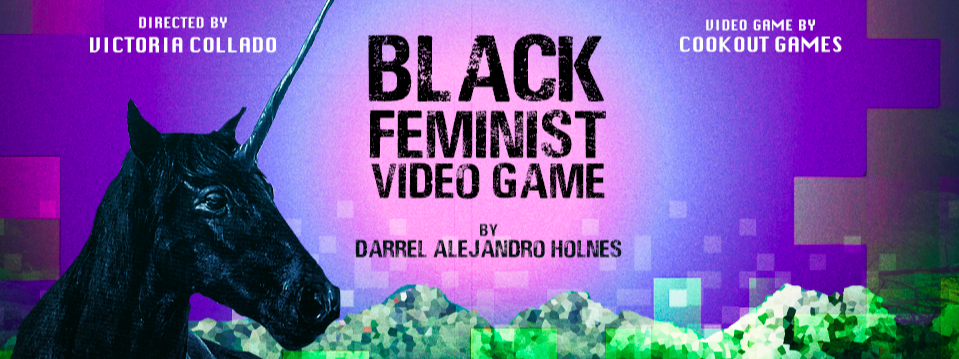Black Feminist Video Game
written by Miranda Allegar - July 10, 2021
Darrel Alejandro Holnes’ Black Feminist Video Game encapsulates many forms of performance, just as it attempts to cover many themes and identities. The piece, produced by The Civilians in Brooklyn, NY, and directed by Victoria Collado, ran from April 27-May 2, 2021, with on-demand viewing through May 9th. The piece explores the understanding of feminism through the eyes of Jonas, a biracial autistic teenager, who live-streams his video-gaming experiences. As such, the piece pushes beyond the simple, integrating a Twitch-like setting, other social networks in the background, feedback from the in-real-life audience, and, most uniquely, a video game interface that Jonas plays through to learn about feminist history.
The piece was born out of Holnes’s work on Black identity in Germany, specifically from an interview he conducted with an autistic friend, as stated by Holnes in a promotional piece for The Civilians. Holnes found his investigations and conversation so intriguing, he began to develop them into a stage play through The Civilians R&D group. However, by the time workshops came around, the theater world had moved online. With this in mind and the pandemic unfolding ahead, Holnes adapted the piece for digital performance.
On the night that I watched the performance, which was streamed via YouTube Live, I viewed alongside about 65 individuals, many of whom found their voice in the live chat function of the work. We were greeted with a waiting screen, announcing, “Hey Social Fam! My stream will start soooooooon!” before Jonas took to the screen to introduce himself. We watched in on a bad first date with Jonas’s crush Nicole before Jonas suggested that he would stream his gameplay experience on a game he’d received from his mother, “Black Feminist Video Game,” with his friend Sabine to attempt to understand where he had gone wrong. Along the way, Jonas stopped to ask the audience for their thoughts on varying gameplay options as Jonas and Sabine weave through the game world’s different realms, which include the “Forest of Feminist Angst,” the “Coven of Many-Faced Mirrors,” the “Realm of Colorism,” and “Peak Patriarchy.”
Meanwhile, Jonas angers his friend, Sabine, before the game traps him, not allowing him to leave until he realizes that his male experience should not be the central focus of this feminist journey. He ultimately realizes that his journey toward feminism should be his goal, rather than definitively claiming the label for himself. He apologizes to both girls during class, getting both a second chance from Nicole and a hesitant reconciliation from Sabine.
The piece speaks to many intersectional experiences, including biracial adolescence, puberty, and autism, and weighs heavily on its delivery of feminist education as Jonas and Sabine literally break the glass ceiling and battle “Karens,” all the while attempting to win the final prize, a lock of Audre Lorde’s hair, as a gift for Jonas’s crush. Its standout features: the world of the game which is colorful and unique, nostalgic and fun to watch, with a bouncy theme song to match, and Jonas’s mother, a socially aware nurse who tries her best to impart her ideals on her son. a character with a small amount of screen time, but a real pleasure to watch.
One of the biggest success of the piece is its inclusivity. Jonas begins his audience interaction by asking for names and pronouns of his “streamers,” as well as inviting the audience to share their experience with video games. Moreover, this production strove for accessibility, especially for Autistic audiences, advertising its intentional “refraining from jarring or sudden audio and visual cues in an attempt to avoid sensory overload, avoiding strobing effects in our design for audiences prone to seizures, creating an Autistic friendly design when choosing the show’s color palette, use of background noise, and consistency of volume levels, choosing a font that is friendly to Dyslexic audiences, and providing subtitles for Deaf and hard-of-hearing audiences in recordings of our performance.”
Black Feminist Video Game then stands out in the virtual theater landscape for its inclusion of original video game design and interface as a part of the story itself and for its accessibility. These two facets in and of themselves highlight the possibility offered by the digital form and serve to emphasize the creativity and intentionality that we must strive to carry with us into post-pandemic theater-making to come.

